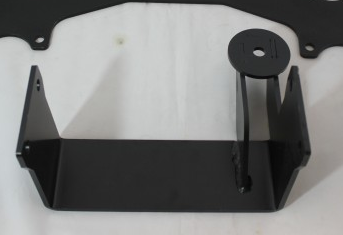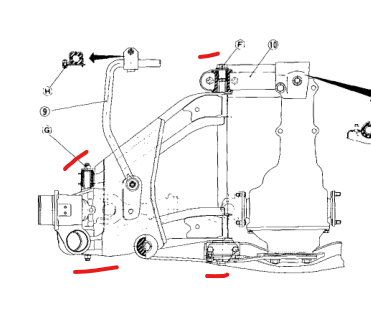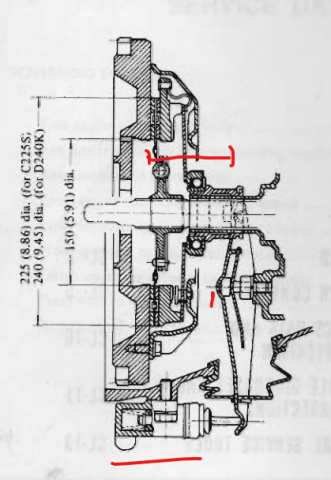
NewZed
Members-
Posts
6698 -
Joined
-
Last visited
-
Days Won
72
Content Type
Profiles
Forums
Blogs
Events
Gallery
Downloads
Store
Everything posted by NewZed
-
Looks like they're using the old style, cantilevered front diff mount, using the four small bolt holes from the original strap. Puts a levered load on those bolts. Not sure what's going on with their other parts. Kind of hard to see in the car. They need a professional photographer.
-
280ZXT would be the 3x2 bolt pattern. Not the 4 hole. Chequered Flag Racing used to sell them, but he needed a certain number of orders to start a batch. Who knows he might have some left. He sells the whole flange that fits to the axle. Maybe mtnickel could make a 3x2 pattern also. Not too difficult, in principle, but would take some time. The 3x2 axles are hard to find so the market is tiny. @mtnickel If you have a 240Z there's a way to adapt a 280ZXT (or 2+2) flange to a 240Z wheel axle, so that you can use the 3x2 pattern axles. But, those flanges are hard to find now also. Overall, the 930 CV axle conversions is the simplest way to get CV's. http://www.chequeredflagracing.net/Datsun.html https://zcardepot.com/products/billet-aluminum-cv-axle-adaptor-930-240z-260z-280z https://whiteheadperformance.com/performance-parts/datsun-240z-260z-280z-parts/cv-conversion-stub-axles-companion-flanges/
-
You got back in to check the clutch, had a concerned look on your face for a while, then got out without saying "hooray, it works". If a person only watched the video they wouldn't know if it actually worked. When is the driving video?
-
I like the undraping of the fender from the engine vibration. You left the audience hanging at the end though....
-
Who is selling this kit? They should know about the axle problem. Could be the axles, could be the adapters, could be both together. Save someone else future problems and tell where you got it. jmortensen has done a ton of work on the axle length problem, along with other people. You could search his name and the topic. You'd probably have to take yours apart to see what's possible, which might make it impossible to return them. Seems like the "plunge joint" side would have some room for shortening and cutting a new notch, since it's just mm's. Found some videos just for fun. There's explosions and stuff. Remember, smoking kills. Good luck.
-
I saw a post recently, can't remember where, where the guy cut a new groove in the axle for the retaining clip, then cut the end off of the axle to shorten it. It was a simple solution to a common problem. You should post a picture of your axles and tell where you got them. If you can't flip the cages then they're not Nissan so nobody really knows what you're working with. The "too long aftermarket CV axle" has been described before.
-
How about converting to the 280ZX design? Same concept except the loads are reversed. Nissan moved the rod to the front of the arm. You'd have to build some structure up front to attach to.
-
I wouldn't consider five "rife". I do like to see an uncommon word used though. Thank you. If ohmster just put the factory dropdowns back in and connected them to the subframe, the usage of the mustache bar pins would be a strengthening move, not a replacement of the factory setup. Then put a bushing on the back diff mount to isolate it from the suspension sub-frame, creating the typical rubber mounted diff situation. Just bench-thinking...
-
He'll probably show up again. Here's links to his other stuff. p.s. but he hasn't "visited" since July 31 2019.
-
Probably doing some CAD work...
-
I'm not an expert in chassis design or even an engineer. So I try to keep things simple. My first thought would be "what do the parts have to do in their original design?" and what will they be doing in the new application? So those two "big" studs hanging down, in their original purpose, only have to stop an 80 lb chunk of metal from moving sideways or fore and aft due to inertia, and also direct loads up in to the frame rail, or resist a tensile load downward, from the torque moment of driving the axles. And they have the front mount to help the fore and aft loads. In the new application they have to resist the weight of the whole back half of the car during cornering. It's much more mass putting a higher side load on the studs. Consider the length of the studs and you can imagine a pretty high leverage on the stud ends as they bend. Then imagine fatiguing over time and it's easy to imagine cracking at the frame rail. And, since it's rubber mounted at the studs the front solid mount will do all of the work until flexing causes the rubber at the studs to compress. More fatiguing at the front end. The studs just just weren't designed for the new loads, no matter how big they are. One view. Fun to think about. Curious, how do you know the factory drop-downs were flexing? In the factory configuration everything is floating in rubber anyway. If I was Apex I'd have some sort of blog where people could point these things out. Then they could explain their thinking, for reassurance. They could even join the forum and respond to this thread.
-
In the end there are usually two basic considerations - what RPM would you like to see on the highway, and how quickly would you like to accelerate. The first is 5th and the second is 1st. The transmission and diff ratios are shown in the various service manuals and can be found on the forum. Around 12 is the typical 1st gear overall ratio. 4th is always 1:1, and 5th varies depending on the transmission. 280Z's - 3.321 x 3.54 = 11.76 ZX's - 3.062 x 3.9 = 11.94 Get the KA's first gear ratio to start. You'll have a lot of torque in a light car so you might not really need a super low first gear.
- 5 replies
-
- drivetrain
- r180
-
(and 2 more)
Tagged with:
-
You're overlooking the main point of the conversation. No evidence of the parts actually in a car. You can always find something to be indignant about on the old internet. If you want to really help Apex out tell them to put some pictures of the parts installed in a car on their web page, or Facebook, or wherever. Even better, parts installed and in use. That would actually be useful to them. Parsing my post to protect their reputation from the 6 people that might actually see it doesn't help much.
-
It was an example, not a comparison. The difference is subtle, but real.
-
I couldn't find anything with a quick look but I seem to remember that they have a larger diameter axle. One last look found this, below, showing a larger pinion shaft also. The whole "Super" thing causes a lot of confusion. I bought a Ford pickup so have seen a lot of it on the truck forums. https://www.mustang6g.com/forums/threads/the-super-8-8.8880/
-
Tell them that you'll buy one after you see pictures of the product actually installed in a car. That's reasonable and sensible. There was a guy on the forum a few years ago that was welding up some very nice looking intake manifolds. But he didn't have any data showing how they worked on an engine. He took many orders, collected lots of money for a Group Buy, took forever to get the first few out, they didn't fit, and he ripped off many of the people who never got a manifold. He lived the good life in the meantime, getting married and probably using all of his ill-gotten money for his wedding. Some people mean well but just can't get it done. Some people are just trying to make some money over the internet. Scammers. Search for "Senza Pari" on the site and around the internet. https://forums.hybridz.org/search/?q=Senza Pari
-
no spark until I turn the key to run
NewZed replied to woton121's topic in S30 Series - 240z, 260z, 280z
Read these instructions, linked below, and do the voltage test. With no jumper wire you should not see the voltage drop that you are seeing. The fact that you are measuring 10 volts kind of implies that your module, or the wiring, is shorted out and passing current when it should not. The reason you get a spark when you turn the key off is because you are "breaking' the spark circuit. It is already "made" because of the bad module or short circuit. That is how spark is made - the circuit through the coil is made, then the spark happens when it is broken. Make, break, make, break... The part number might not be right but the instructions are all the same, for the first series of Pertronix Ignitors. The later modules have a safety feature that switches off the current so the module doesn't burn up. Have you ever left the key On for an extended period? https://static.summitracing.com/global/images/instructions/pnx-1281.pdf "4.Turn the ignition switch to the “on” position and note voltage reading on the voltmeter. Quickly read the voltage and turn ignition “OFF”. Leaving ignition “ON” for an extended period could result in permanent damage to the Ignitor." -
The relationship to the clutch fork pivot ball in the transmission case is what matters. There are several different /Nissan throwout bearing sleeve/collar heights to match the several different pressure plate heights. You'll want to compare where the Chevy flywheel surface sits, compared to where the Nissan flywheel did, in relation to the mating surface of the engine and transmission. Lots of ways to mess it up. The slave cylinder, fork, and pivot ball relationship determines where end of the fork starts its travel.
-
Driveshaft length for R200 Short Nose swap
NewZed replied to Dwayne_The_Rock_Datsun's topic in Drivetrain
If you want to save some money you might find that a 2+2 propeller shaft from a 300ZX can be cut down. Instead of having a custom shaft made. Just a thought. Propeller shaft dimensions are in the FSM's or available through Nissan. -
Driveshaft length for R200 Short Nose swap
NewZed replied to Dwayne_The_Rock_Datsun's topic in Drivetrain
You could take some measurements. If you don't have the short nose ask someone out here to measure a short nose. If you're buying a short nose mounting kit the kit maker should have the number for you. If you're building your own mounts, make sure to read all of the threads about problems with mounting the short nose. They tend to tear out the old mounting holes due to the increased leverage. Lengthening the dirveshaft is the least of your potential problems. -
Looks decent.
-
My advice would be to not worry about it. You might check the other chapters in the FSM, they have smaller wiring diagrams for each component. And the 1975 FSM is the first EFI FSM. I've found that it has a lot of errors in it. Use a meter and see what's what.
-
Need tuning help/diagnosis '78 280Z Factory EFI
NewZed replied to TheWeekendWagon's topic in S30 Series - 240z, 260z, 280z
Adjusting the spring tensions won't help with idle gases problems. More AFM's get screwed up by fiddling with the spring tension. The atlanticz page is meant for fixing those problems, fixing screwed up AFM's, not "tuning". -
Need tuning help/diagnosis '78 280Z Factory EFI
NewZed replied to TheWeekendWagon's topic in S30 Series - 240z, 260z, 280z
Most AFM's are rebuilt by FuelInjectionCorp. I could run the idle air screw all the way out and it would still run rich. Other people have reported the same problem. I had to install an adjustable FPR to lower the fuel pressure to get it to pass if I did not swap an old Nissan AFM in. I think that FuelInjectionCorp just didn't do a good job of matching specs. to Nissan's AFM. https://fuelinjectioncorp.com/




